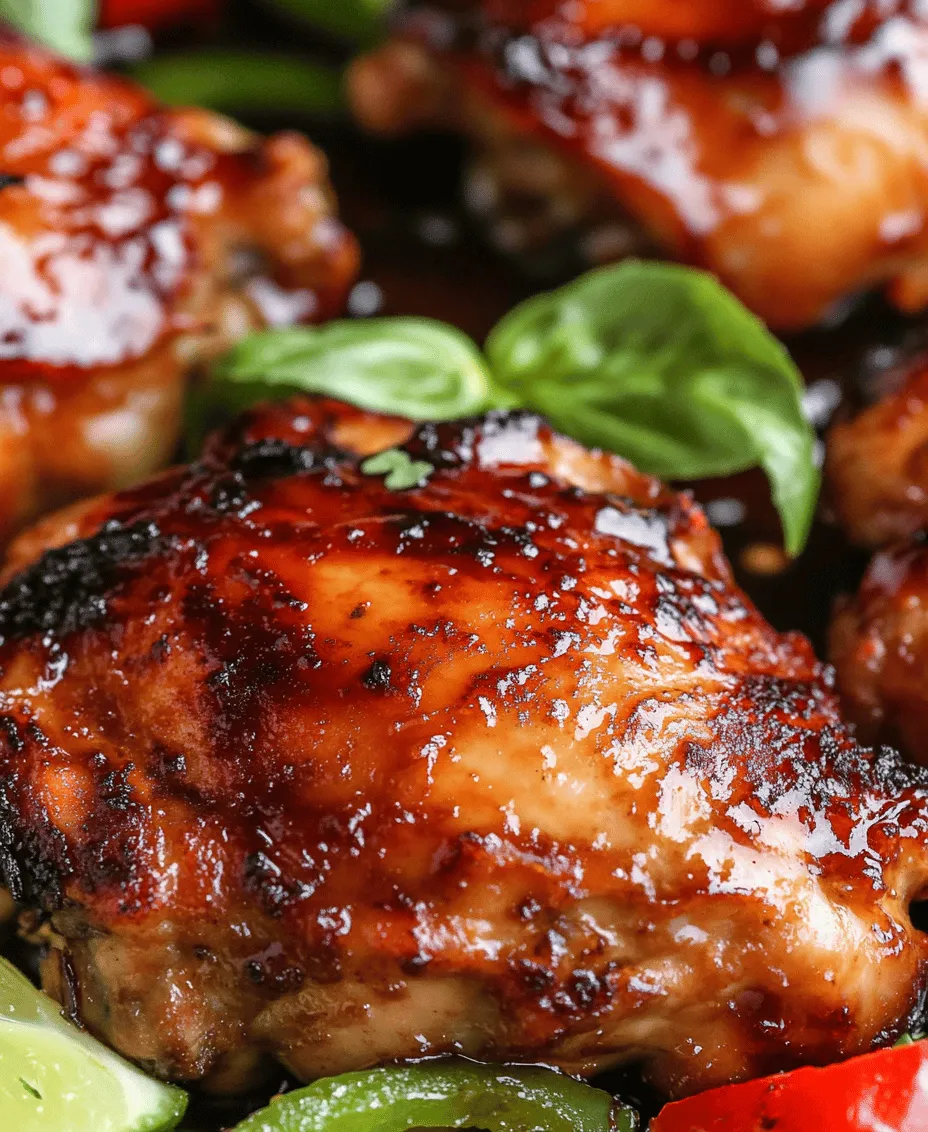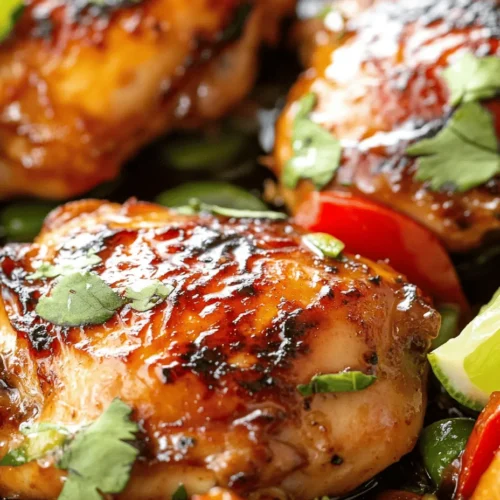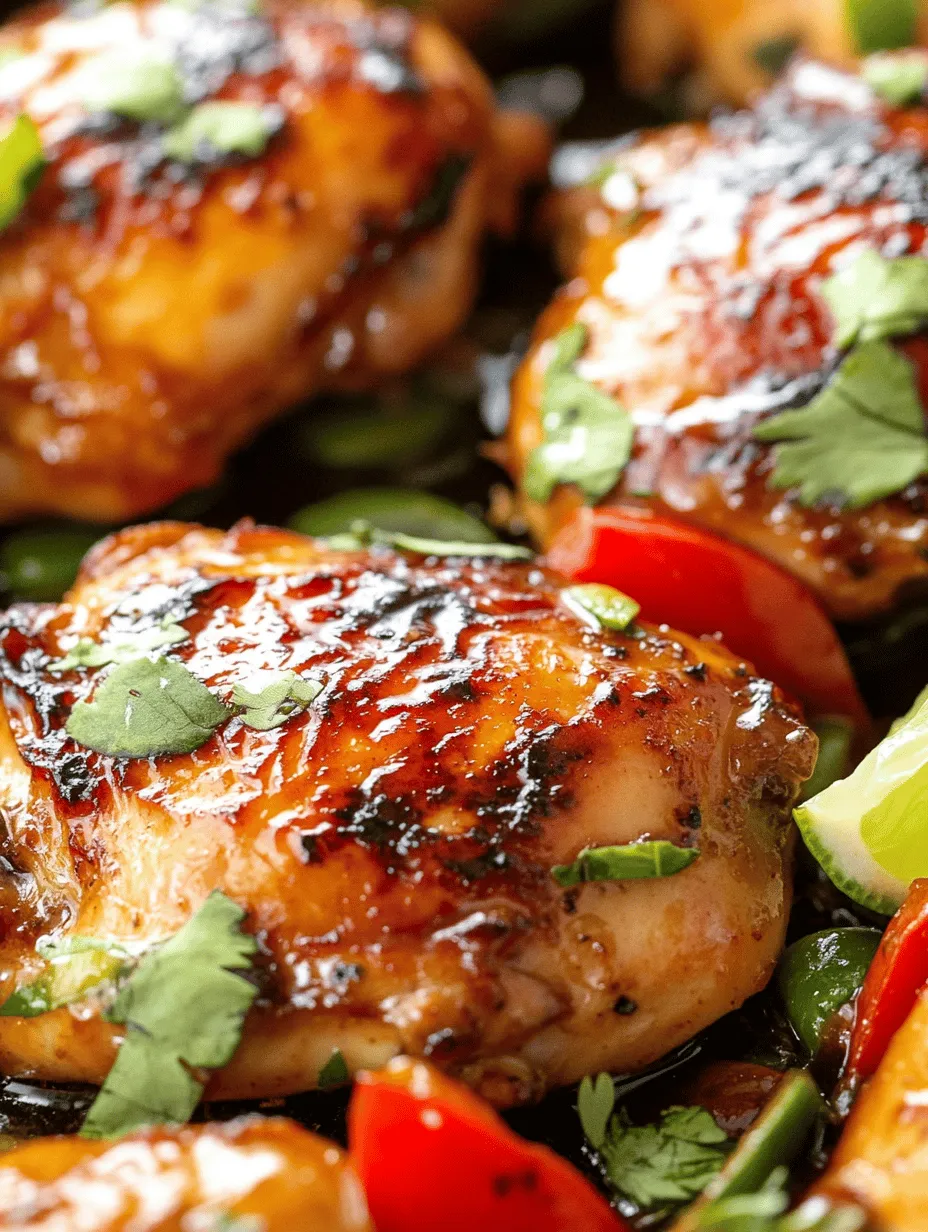Introduction
Thai cuisine is renowned for its vibrant flavors, intricate aromas, and the perfect balance of sweet, sour, salty, and spicy elements. It has captivated food lovers around the globe, making it one of the most beloved culinary traditions. The rich tapestry of Thai dishes reflects its cultural heritage, combining influences from neighboring countries and showcasing the use of fresh ingredients. Among those dishes, Sweet and Spicy Thai Chicken stands out as a delightful fusion of flavors that tantalizes the taste buds and satisfies the appetite.
Sweet and Spicy Thai Chicken is a perfect representation of what makes Thai food so appealing. This recipe marries the bold heat of spices with the comforting sweetness of honey and brown sugar, creating a dish that is both exciting and accessible. Ideal for busy weeknights, this dish offers a quick and easy preparation without sacrificing flavor or quality. Whether you’re a seasoned chef or a novice cook, this recipe promises to deliver a satisfying meal that your family and friends will love.
What makes this dish particularly appealing is its bright and colorful ingredients. The combination of tender chicken, vibrant bell peppers, and fresh herbs not only creates a feast for the eyes but also ensures a balanced taste experience. As we delve deeper into the preparation of Sweet and Spicy Thai Chicken, you’ll discover how to harness the power of these ingredients to create a dish that is as enjoyable to make as it is to eat.
Understanding the Ingredients
To create the perfect Sweet and Spicy Thai Chicken, it’s essential to understand the key ingredients that contribute to its distinctive flavor profile. Each element serves a specific purpose, enhancing the overall dish and creating a harmonious blend of tastes and textures.
Boneless, Skinless Chicken Thighs
The star of this recipe is boneless, skinless chicken thighs. Compared to chicken breasts, thighs are often more flavorful and tender, making them an excellent choice for this dish. Their higher fat content ensures that the meat remains juicy during cooking, while also absorbing the marinade’s flavors beautifully. This makes the chicken thighs the ideal canvas for the sweet and spicy elements of the dish.
Soy Sauce and Fish Sauce
No Thai dish is complete without the umami richness that soy sauce and fish sauce provide. Soy sauce adds a deep, savory note that complements the sweetness of the honey and brown sugar, while fish sauce introduces a unique salty flavor that enhances the overall taste. The combination of these two sauces creates a complex flavor base that is quintessential in Thai cooking.
Honey and Brown Sugar
To achieve the signature sweetness of Sweet and Spicy Thai Chicken, honey and brown sugar are used. Honey brings a natural sweetness that pairs beautifully with the heat of the spices, while brown sugar contributes a rich, caramel-like flavor. Together, they balance the dish’s heat and create a deliciously sticky glaze that clings to the chicken.
Sriracha
For those who crave heat, Sriracha is the go-to ingredient in this recipe. This popular Thai hot sauce adds a kick of spiciness and a touch of tang that elevates the dish. Adjust the amount of Sriracha used to suit your heat preference, ensuring that you achieve the perfect balance of flavors.
Garlic and Ginger
Aromatic foundations like garlic and ginger are essential in Thai cooking. They not only add depth of flavor but also contribute to the overall aroma of the dish. Garlic provides a pungent, savory note, while ginger adds a refreshing zest that brightens the flavors. Together, they form the backbone of the marinade, infusing the chicken with their delightful essence.
Bell Peppers
Adding crunch and color to the dish, bell peppers are a great addition to Sweet and Spicy Thai Chicken. Their natural sweetness complements the other ingredients, while their crisp texture provides a satisfying contrast to the tender chicken. You can use a mix of red, yellow, or green bell peppers to create an eye-catching presentation.
Fresh Basil
A signature herb in Thai cuisine, fresh basil brings a unique flavor that enhances the overall dish. Its aromatic and slightly peppery notes add brightness and freshness to the Sweet and Spicy Thai Chicken. For the best results, use Thai basil if available, as it has a more distinct flavor profile compared to regular basil.
Lime Juice
To round off the flavors, lime juice is added to the dish. Its acidity cuts through the sweetness and richness, brightening the overall taste. A squeeze of fresh lime juice just before serving adds a refreshing zing that elevates the dish to new heights.
Marinating the Chicken
Marinating the chicken is a crucial step in developing the deep flavors characteristic of Sweet and Spicy Thai Chicken. The marinade not only infuses the chicken with the delicious flavors of the ingredients but also helps to tenderize the meat, resulting in a juicy and flavorful final product.
Importance of Marinating
The process of marinating allows the chicken to absorb the flavors of the ingredients, creating a more cohesive and delicious dish. By allowing the chicken to sit in the marinade for a period of time, the flavors meld together, enhancing the overall taste and ensuring that each bite is packed with flavor.
Step-by-Step Guide to Marinating Chicken
1. Prepare the Marinade: In a mixing bowl, combine soy sauce, fish sauce, honey, brown sugar, Sriracha, minced garlic, and grated ginger. Whisk until the sugar has dissolved, and the ingredients are well combined.
2. Trim the Chicken: If necessary, trim any excess fat from the boneless, skinless chicken thighs. This ensures an even cooking process and prevents the dish from becoming too greasy.
3. Marinate the Chicken: Place the chicken thighs in a resealable plastic bag or a shallow dish. Pour the marinade over the chicken, ensuring that each piece is well coated. Seal the bag or cover the dish with plastic wrap.
4. Refrigerate: Allow the chicken to marinate in the refrigerator for at least 30 minutes, but preferably for 2 to 4 hours. For optimal results, marinating overnight will yield even more flavorful chicken.
5. Bring to Room Temperature: Before cooking, take the marinated chicken out of the refrigerator and let it sit at room temperature for about 15-20 minutes. This helps ensure even cooking.
Recommendations for Marinating Duration
While a minimum of 30 minutes is recommended for a basic flavor infusion, longer marinating times will yield more pronounced flavors. A duration of 2 to 4 hours is ideal for a well-rounded taste experience, while marinating overnight can result in a deeply flavorful dish. However, avoid marinating for more than 24 hours, as the acid in the marinade can begin to break down the chicken, leading to a mushy texture.
Tips for Optimal Results
– Use Fresh Ingredients: Fresh garlic, ginger, and herbs will impart a more vibrant flavor than dried counterparts.
– Adjust the Heat: If you’re not a fan of too much spice, reduce the amount of Sriracha in the marinade to suit your taste.
– Taste the Marinade: Before adding the chicken, taste the marinade to ensure the balance of flavors meets your preference. Adjust as needed by adding more sweetness, saltiness, or acidity.
Cooking Techniques
Once the chicken has marinated, it’s time to cook it to perfection. There are several cooking methods suitable for Sweet and Spicy Thai Chicken, each offering its own benefits.
Overview of Cooking Methods
– Sautéing: This method involves cooking the chicken in a hot pan with a small amount of oil. Sautéing allows for quick cooking and can create a beautiful caramelization on the chicken, enhancing its flavor.
– Stir-Frying: A staple in many Asian cuisines, stir-frying involves cooking the chicken over high heat in a wok or a large skillet, with constant stirring. This technique ensures that the chicken cooks evenly and remains tender while also allowing the vegetables to maintain their crunch.
Benefits and Differences
Both sautéing and stir-frying are excellent methods for cooking Sweet and Spicy Thai Chicken. Sautéing is ideal for beginners or those looking for a straightforward approach, while stir-frying is perfect for those who want to achieve an authentic Thai flavor. Stir-frying also allows for quicker cooking times due to the high heat and constant motion, which helps lock in moisture and flavor.
In summary, the journey to creating a delicious Sweet and Spicy Thai Chicken begins with understanding the essential ingredients and the importance of marinating. By taking the time to properly prepare the chicken and choose the right cooking method, you will set the stage for an unforgettable dish that showcases the best of Thai cuisine. As we move forward, we will delve into the specific cooking steps and tips to ensure your Sweet and Spicy Thai Chicken turns out perfectly every time.

Detailed Instructions for Cooking the Chicken
To achieve perfectly cooked Sweet and Spicy Thai Chicken, start by marinating your chicken pieces in the sweet and spicy sauce for at least 30 minutes, or ideally, a few hours if you have the time. This not only infuses the chicken with flavor but also helps tenderize the meat. When you’re ready to cook, heat a large skillet or wok over medium-high heat and add a tablespoon of vegetable oil.
Once the oil is hot, add the marinated chicken in a single layer, ensuring not to overcrowd the pan; this allows the chicken to sear and caramelize properly. Cook the chicken for about 5 to 7 minutes on each side, or until it reaches an internal temperature of 165°F (75°C). To ensure even cooking, you can use a meat thermometer to check the doneness. If you notice that the chicken is browning too quickly, reduce the heat to medium. The goal is to achieve a beautifully golden-brown crust while keeping the inside juicy and tender.
Tips on Achieving Desirable Caramelization
Achieving that coveted caramelization on your chicken is essential for enhancing the flavor profile of the dish. Here are several tips to ensure you get the best results:
1. Pat Dry: Before marinating, pat the chicken dry with paper towels. Removing excess moisture allows for better searing and caramelization.
2. High Heat: Use medium-high to high heat when cooking. This temperature is crucial for browning the sugars in the marinade, creating a delicious crust.
3. Don’t Move the Chicken: Once you place the chicken in the skillet, minimize the flipping and moving. Let it sit undisturbed for a few minutes to allow a crust to form.
4. Use Brown Sugar: The marinade should include brown sugar, which caramelizes beautifully and adds depth to the flavor.
5. Baste for Extra Flavor: As the chicken cooks, consider spooning some of the leftover marinade over the top. This not only adds moisture but enhances the flavor and helps with caramelization.
Incorporating Vegetables
To balance the dish’s sweetness and spice, incorporating fresh vegetables is essential. Bell peppers are an excellent choice; their crisp texture and subtle sweetness complement the chicken perfectly.
1. Role of Bell Peppers: When you add bell peppers—especially a mix of red, yellow, and green—you not only introduce vibrant colors but also a satisfying crunch that contrasts with the tender chicken. Their natural sweetness pairs beautifully with the spicy elements of the dish.
2. Suggested Variations of Vegetables: While bell peppers are a staple, you can experiment with other vegetables such as snap peas, broccoli, or zucchini. These options add variety and nutrition while still maintaining that fresh crunch.
3. Techniques for Cooking Vegetables: To keep the vegetables crisp, add them to the skillet after the chicken has been cooking for about 10 minutes. Stir-fry them briefly for 3 to 5 minutes until they are bright and tender-crisp. This method ensures they retain their texture and nutrients while infusing with the sauce.
Finishing Touches
The final touches of your Sweet and Spicy Thai Chicken are key to elevating the dish’s flavor and presentation.
1. Significance of Adding Fresh Basil: Toward the end of cooking, add a generous handful of fresh basil. Its aromatic quality enhances the dish, imparting a bright, herbal note that balances the rich flavors.
2. Incorporating Herbs Properly: To preserve the freshness of the basil, tear the leaves instead of chopping them finely. This technique releases the essential oils without bruising the leaves too much, ensuring the flavor remains vibrant.
3. Suggestions for Garnishing: For visual appeal, consider garnishing your dish with additional basil leaves, a sprinkle of sesame seeds, or finely sliced green onions. This not only enhances the dish’s presentation but also adds texture and a hint of flavor on top.
Serving Suggestions
Serving Sweet and Spicy Thai Chicken can be an art in itself. Here are some best practices to consider:
1. Best Practices for Serving: Serve the chicken hot, straight from the skillet, to maintain its juiciness. A large serving platter allows guests to see the vibrant colors and encourages sharing.
2. Ideal Accompaniments: While jasmine rice is a classic pairing, consider serving the chicken with coconut rice or quinoa for a twist. These options soak up the sauce beautifully and add their unique flavors.
3. Recommendations for Side Dishes: To complement the main entrée, consider a side of Thai cucumber salad, which adds a refreshing crunch, or spring rolls for a delightful appetizer. Both enhance the dining experience with additional textures and flavors.
4. Ideas for Presentation: Elevate your plate by layering the rice first, then topping it with the chicken and vegetables. Drizzle with extra sauce and finish with your garnishes. Using a ring mold can help create a structured presentation that looks professional.
Nutritional Information
Understanding the nutritional content of your dish can help you appreciate its health benefits.
1. Breakdown of Calories and Macronutrients: A serving of Sweet and Spicy Thai Chicken typically contains around 350 calories, with approximately 25g of protein, 15g of fat, and 30g of carbohydrates. This makes it a balanced meal option.
2. Key Vitamins and Minerals: The chicken provides essential protein and B vitamins, while bell peppers are rich in vitamin C and antioxidants. Fresh basil adds additional vitamins A and K.
3. Balancing Indulgence with Nutrition: While this dish is indulgent in flavor, the inclusion of lean protein and fresh vegetables ensures that it is also nutritious. Enjoying flavorful meals like this at home allows for balancing pleasure with health.
Conclusion
Sweet and Spicy Thai Chicken is a delightful dish that masterfully combines sweet, savory, and spicy elements, providing a fulfilling dining experience. Its ease of preparation makes it perfect for weeknight dinners or special occasions alike. Experimenting with varying vegetables and personalizing the recipe allows you to make it your own.
Cooking is not just about nourishing ourselves; it’s also about creating memories and sharing experiences with loved ones. So gather your friends and family, cook this delicious meal together, and enjoy the flavors and joy it brings to your table.



